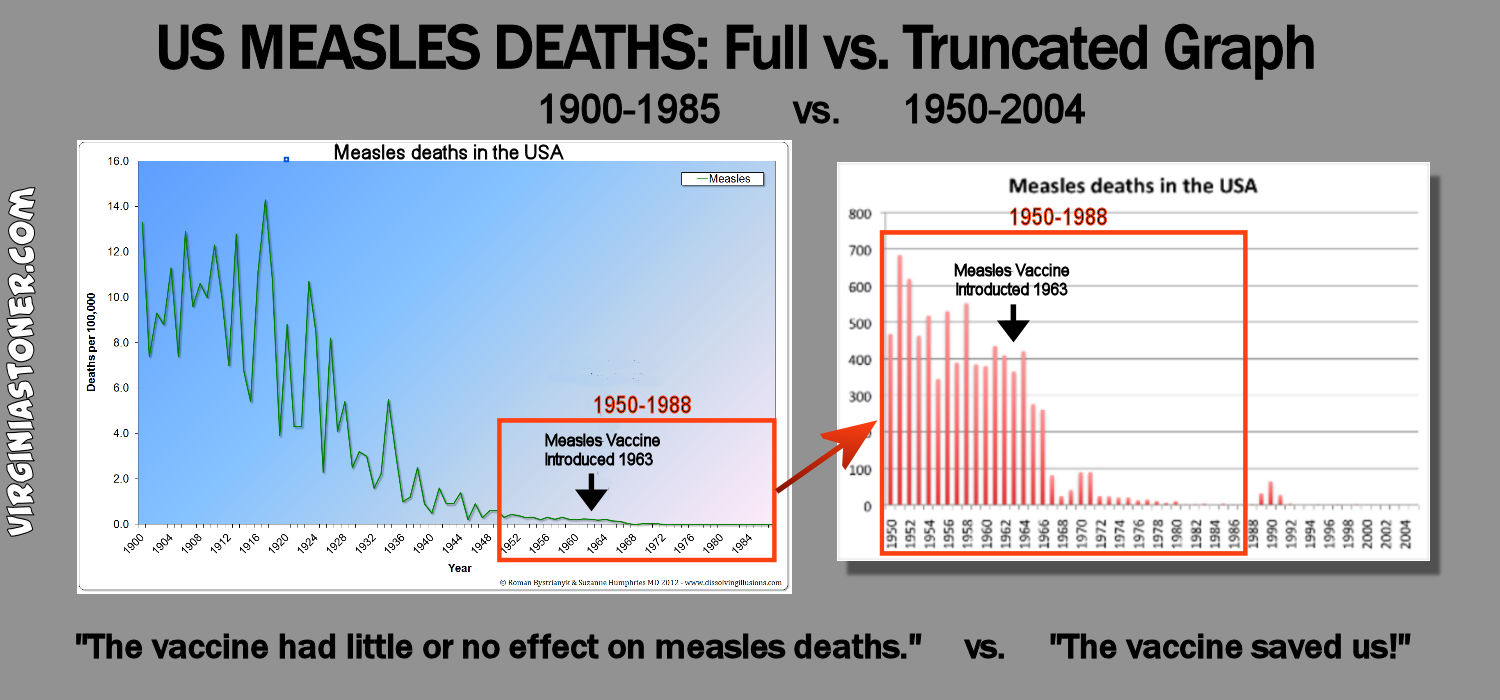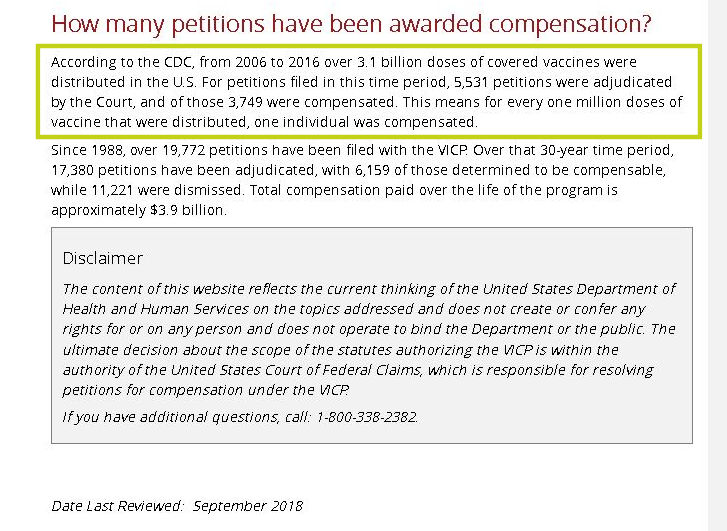Lies, Damn Lies and Truncated Graphs
Take a look at these two graphs of measles deaths in the US. The first graph shows deaths going back to 1900. You will rarely see a complete graph like this in scholarly articles promoting measles vaccination. Instead, you will usually find graphs similar to the second one, showing deaths from 1950 onward.
The areas outlined in orange are the same data-- measles deaths from 1950 to 1988. It looks more dramatic in the second graph because it’s been stretched vertically a lot.
The first graph shows the vaccine had little or no impact on measles deaths, which had already declined to historically low levels by the time it was introduced.
By truncating (omitting) all the death data prior to 1950, and stretching out the numbers, the second graph creates the impression the vaccine resulted in a dramatic decline in measles deaths. In fact, all the graph depicts is the tail end of a long declining trend in deaths that began decades earlier.
Truncating data (omitting certain data to manipulate perceptions) is Sleazy Marketing 101. This example is even more insidious than typical sleazy marketing, because it’s being used in textbooks and ‘authoritative’ papers, as well as in media promotion. It’s being used to fabricate a false reality, where the vaccine is responsible for stopping widespread death from measles in the US.
A little disease history
The following historical facts are not in dispute, to the best of my knowledge. The graph of disease mortality rates and its sources can be found in the book Dissolving Illusions. By all means, verify the data with any sources you choose. I’ve never found any evidence to refute it, and the data for the UK is very similar.
In the late 1800s in the US, urban living conditions were brutal. Children toiled along with their parents in factories and mines for 16 hours a day, 6 or 7 days a week, just to scrape a bare living. Cities were crowded and filthy, with open sewage and garbage littering the streets, and infestations everywhere. Malnutrition and disease were rampant.
Slowly, a public health revolution occurred. Sanitation systems were built, and clean water piped in. Food supplies improved, as did working conditions. The result was a dramatic improvement in public health. By 1950, deaths from common diseases such as measles had plummeted by 95%, and the decline was still continuing.
This plummeting occurred prior to the introduction of most vaccines in use today, including the measles vaccine, and it occurred for diseases for which there has never been a vaccine as well.
What measles was like in the 1950s
Most children got measles—an estimated 3.5 million cases every year in the US. For the vast majority, it was a mild rash and fever lasting about a week, followed by full recovery, and lifelong immunity to measles. It was so mild, 9 out of 10 cases didn’t even bother to consult a doctor. Since doctors do the reporting, the true number of measles cases can only be estimated:
"Before measles vaccine was licensed in 1963, an average of 400,000 measles cases were reported each year in the United States. However, because virtually all children acquired measles, the number of cases probably approached 3.5 million per year." —Measles, Mumps, and Rubella -- Vaccine Use and Strategies for Elimination of Measles, Rubella, and Congenital Rubella Syndrome and Control of Mumps: Recommendations of the Advisory Committee on Immunization Practices, May 22, 1998 / 47(RR-8);1-57
Here’s what doctors were saying about measles in 1959:
"In the majority of children the whole episode has been well and truly over in a week, from the prodromal phase to the disappearance of the rash, and many mothers have remarked ‘how much good the attack has done their children’, as they seem so much better after the measles.”
“In this practice measles is considered as a relatively mild and inevitable childhood ailment that is best encountered any time from 3 to 7 years of age. Over the past 10 years there have been few serious complications at any age, and all children have made complete recoveries.”
From Measles: Reports from General Practitioners, British Medical Journal, February 7, 1959.
Measles was portrayed in popular culture in the 1950s and 1960s as something that was not serious, and could even be good for a few laughs. Here’s an 8-minute video compilation of examples:
That’s not to say measles could never be dangerous. It still is, for people whose immune system is weakened, who are at increased risk from virtually everything. It is said to kill many in the Third World, where malnutrition, poor sanitation and brutal living conditions are common, as they once were here. The vaccine industry uses those Third World death numbers to create fear of measles in the US.
A recent article from WaPo tells us we should all vaccinate because measles was quite scary in those days. But when you compare the risks to the known risks of vaccination, it’s not so clear. Remember, by the time the vaccine came out in 1963, measles deaths had been steadily declining for at least 5 decades already. There’s no reason to think that trend wouldn’t have continued up to the present day, with or without the vaccine, and be much lower now than it was in 1960:
“In the 1960s, measles infected about 3 million to 4 million people in the United States each year. More than 48,000 people were hospitalized, and about 4,000 developed acute encephalitis, a life-threatening condition in which brain tissues become inflamed. Up to 500 people died, mainly from complications such as pneumonia and encephalitis.” --Measles: Why it’s so deadly, and why vaccination is so vital, Washington Post, Paul Duprex, Feb. 16, 2019.
I don’t know if WaPo’s numbers are correct, but given the source, I’m sure they haven’t been understated. If the numbers are to be believed, the chances of dying from measles were 1 in 7,000; the chances of life-threatening complications were 1 in 875; and the chances of hospitalization were 1 in 73.
Bear in mind those risks are generalizations: strong, healthy children rarely have measles complications, so their actual chances would be much lower than for children in more delicate health.
The risks of measles vaccination
I don’t want to minimize the tragedy of harm to anyone from measles. But, all vaccines come with an undisputed risk of serious injury or death. That’s why we have a Vaccine Injury Compensation Program. Only the frequency and scope of the damage is in dispute. Surely serious injury and death from measles vaccination is equally tragic.
Moreover, no vaccine works all the time. When it doesn’t work, those people incur the risks of both measles and the measles vaccine.
Many people think the risks of vaccination are ‘negligible’ or ‘one in a million.’ But the CDC’s own data contradicts this belief, even as the CDC intentionally fosters it by wording its findings in a confusing way that suggests it.
The Health Resources and Services Administration (HRSA) website tells us that, according to the CDC’s numbers, there is a one in a million chance of an award in the Vaccine Injury Compensation Program (VICP) for every vaccine dose distributed.
Note this doesn’t mean there is a 1 in a million risk of serious vaccine injury or death—far from it. I break down the meaning in more detail in another article, but to sum it up:
In order to get an injury award in the VICP, a case first has to be filed in the VICP. It’s very unlikely more than 10% of viable vaccine injury claims are ever filed in the VICP, and the percentage is likely much lower, 1% or less. Also, not all vaccine doses “distributed” were actually administered to anyone—although I’m going to ignore that factor here for simplicity.
That means the risk of serious injury or death from a vaccine (not just a VICP award) is much higher than 1 in a million—it’s between 1 in 10,000 and 1 in 100,000 per dose of vaccine.
The CDC currently recommends 3-4 doses of the measles, mumps, rubella vaccine (MMR) vaccine over a lifetime. With 4 doses, the risk of serious injury or death from measles vaccination, according the CDC’s numbers, would be between 1 in 2,500 and 1 in 25,000.
Conclusions
Vaccines are a global multi-billion-dollar industry, deeply entwined with government powers that promote and even mandate consumption of it products. Government and industry work together with the media to convince the public that vaccines—all of them—are ‘safe and effective and saved the world.’ Together, they largely control all vaccine and disease related research.
You may believe this vaccine agenda is for the good of humanity and based on sound science—I’m sure most of the people carrying out the agenda do. But what if you are wrong?
Why would an industry with a ‘miraculous’ product engage in so much deception to sell it? I’ve provided a few examples here, but there are hundreds more.
Even if you believe a government has the right to force or coerce vaccination of its citizens, surely you would agree it first has an obligation to formally justify each mandated vaccine with a comprehensive and objective risk/benefit analysis that is available for public scrutiny and comment, for both the vaccine and the natural infection. Simply parroting industry slogans such as “vaccines have saved millions of lives” and “vaccines are extraordinarily safe and effective” doesn’t cut it, where the government is demanding individuals incur a risk of serious harm and death ‘for the greater good.’
Even without vaccine mandates, informed consent to vaccination requires a comprehensive and objective risk/benefit analysis for both the vaccine and the natural infection. Instead, patients are getting sales pitches and marketing brochures. With a huge budget and high-powered connections in government and media, there are many creative ways to manufacture a false vaccine reality.
Caveat emptor—while you still have a choice.


